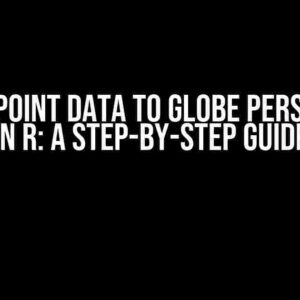Pandas, the powerful Python library for data manipulation and analysis, has an extensive documentation that can sometimes leave even the most seasoned developers scratching their heads. One of the most frequently asked questions among pandas enthusiasts is “How is this description understood in the pandas documentation?” In this article, we’ll delve into the world of pandas documentation and uncover the secrets behind this enigmatic description, providing you with a comprehensive guide to mastering the pandas library.
What is the Description?
The description in question is a crucial part of the pandas documentation, providing a concise summary of the library’s functionality. It reads:
"DataFrame is a 2-dimensional labeled data structure with columns of potentially different types. You can think of it like a spreadsheet or SQL table, or a dictionary of Series objects."This description may seem straightforward at first glance, but it’s packed with subtleties that require a deeper understanding of pandas and its underlying data structures.
Breaking Down the Description
To fully comprehend this description, let’s break it down into its constituent parts and explore each component in detail.
2-Dimensional Labeled Data Structure
A 2-dimensional data structure, in the context of pandas, refers to a table-like structure with rows and columns. The rows represent individual data points, while the columns represent variables or features associated with those data points. The labeling part is crucial, as it implies that each row and column has a unique identifier, allowing for efficient data manipulation and retrieval.
>>> import pandas as pd
>>> data = {'Name': ['John', 'Mary', 'David'],
'Age': [25, 31, 42],
'Country': ['USA', 'UK', 'Australia']}
>>> df = pd.DataFrame(data)
>>> print(df)| Name | Age | Country |
|---|---|---|
| John | 25 | USA |
| Mary | 31 | UK |
| David | 42 | Australia |
In this example, the DataFrame `df` has three columns (Name, Age, Country) and three rows, each with a unique combination of values.
Columns of Potentially Different Types
This part of the description highlights one of pandas’ most powerful features: the ability to handle columns with different data types. In the previous example, the columns `Name` and `Country` contain strings, while the `Age` column contains integers. Pandas seamlessly handles this heterogeneity, allowing you to perform operations on each column individually or collectively.
>>> df.dtypes
Name object
Age int64
Country object
dtype: objectThe `dtypes` attribute reveals the data type of each column, showcasing pandas’ ability to accommodate diverse data types.
You Can Think of it Like a Spreadsheet or SQL Table
This phrase is more than just an analogy – it’s a fundamental concept in understanding pandas’ data structures. Imagine a spreadsheet with rows and columns, where each cell contains a value. Similarly, an SQL table consists of rows and columns, with each column having a specific data type. Pandas’ DataFrame mirrors this structure, making it an ideal tool for data manipulation and analysis.
A Dictionary of Series Objects
A Series is a one-dimensional labeled array of values, similar to a column in a spreadsheet. A dictionary of Series objects, in the context of pandas, implies that each column in a DataFrame can be treated as a separate Series. This allows for flexible data manipulation and analysis, as you can operate on individual Series or combine them to create new ones.
>>> df['Name'] # Accessing a single Series (column)
0 John
1 Mary
2 David
Name: Name, dtype: objectPractical Applications
Now that we’ve deconstructed the description, let’s explore some practical applications of pandas’ DataFrame:
Data Cleaning and Preprocessing
Pandas provides an array of functions for handling missing data, data normalization, and feature scaling, making it an essential tool for data preprocessing.
>>> df.dropna() # Drop rows with missing values
>>> df.fillna('Unknown') # Fill missing values with a specific value
>>> df.normalize() # Normalize data valuesData Analysis and Visualization
Pandas integrates seamlessly with popular data visualization libraries like Matplotlib and Seaborn, allowing you to create informative and engaging visualizations.
>>> import matplotlib.pyplot as plt
>>> df.plot(kind='bar') # Create a bar chart
>>> plt.show()Data Manipulation and Transformation
Pandas offers a wide range of functions for data manipulation, including filtering, grouping, and pivoting, making it easy to transform and reshape your data.
>>> df.filter(like='Name') # Filter rows based on a condition
>>> df.groupby('Country').mean() # Group by a column and calculate mean
>>> df.pivot(index='Name', columns='Country', values='Age') # Pivot dataConclusion
The description “DataFrame is a 2-dimensional labeled data structure with columns of potentially different types. You can think of it like a spreadsheet or SQL table, or a dictionary of Series objects” is more than just a brief summary of pandas’ functionality – it’s a gateway to understanding the complexities and capabilities of the pandas library. By breaking down this description and exploring its components, we’ve gained a deeper appreciation for the power and flexibility of pandas’ DataFrame. Whether you’re a seasoned developer or a newcomer to the world of data science, mastering pandas is essential for unlocking the full potential of your data.
Remember, the next time you encounter a cryptic description in the pandas documentation, take a step back, break it down, and explore its components. With patience, practice, and persistence, you’ll unlock the secrets of pandas and become a data manipulation master.
Frequently Asked Questions
-
Q: What is the main difference between a pandas Series and a pandas DataFrame?
A: A Series is a one-dimensional labeled array of values, while a DataFrame is a 2-dimensional labeled data structure with columns of potentially different types.
-
Q: How do I handle missing data in a pandas DataFrame?
A: You can use the `dropna()` function to drop rows with missing values, the `fillna()` function to fill missing values with a specific value, or the `interpolate()` function to fill missing values using interpolation.
-
Q: Can I use pandas for data visualization?
A: Yes, pandas integrates seamlessly with popular data visualization libraries like Matplotlib and Seaborn, allowing you to create informative and engaging visualizations.
Further Reading
Stay tuned for more in-depth guides and tutorials on mastering pandas and unlocking the secrets of data science!
Frequently Asked Question
Get to the bottom of how the pandas documentation interprets a crucial description!
What does the description in the pandas documentation refer to?
The description in the pandas documentation typically refers to a brief explanation or summary of a particular function, method, or feature. It’s meant to provide context and help users understand how to use the respective component effectively.
Is the description in the pandas documentation always accurate?
While the pandas documentation strives to maintain accuracy, it’s not infallible. The library is constantly evolving, and updates might not always be reflected in the documentation immediately. It’s essential to consult multiple sources and test the functions yourself to ensure you’re using them correctly.
Can I rely solely on the description in the pandas documentation for implementation?
No, it’s not recommended to rely solely on the description for implementation. The description is meant to provide a high-level understanding, but it’s essential to consult the function’s syntax, parameters, and return types to ensure correct usage. Additionally, reviewing examples, tutorials, and community resources can help you implement the function correctly.
Are there any specifics I should focus on in the pandas documentation description?
Yes, pay attention to keywords, parameter names, and data types mentioned in the description. These details can significantly impact the function’s behavior and your implementation. Also, watch out for any notes, warnings, or versions mentioned, as they might affect the function’s usage.
Where can I find additional resources to supplement the pandas documentation description?
You can find additional resources on the official pandas website, including tutorials, examples, and community-maintained resources like Kaggle, GitHub, and Stack Overflow. These resources can provide more in-depth explanations, examples, and real-world scenarios to help you better understand and implement pandas functions.




